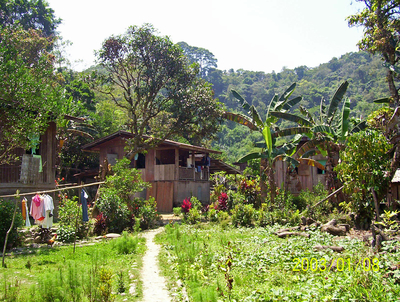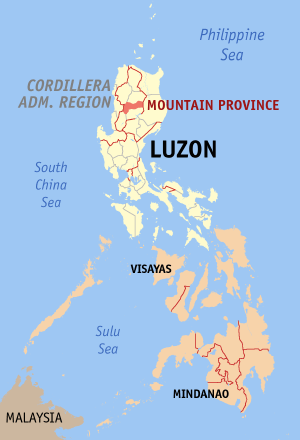Introduction

Figure 1: A house in the village of Buneg which is part of the Apayao Province (Courtesy of EWB Imperial)
Background
The Apayao Province in the Philippines is a rural area located in Luzon which is towards the north end of the country as shown in figure 2 below.
Since this province contains mainly mountainous terrain it would be difficult and illogical to supply grid electricity to the residents. Figure 1 (left) shows a typical village house
structure in the Buneg village where EWB have already helped installed micro hydroelectric plants, as you can see it would be quite difficult to try and implement grid electricity especially
with the terrain shown in the background.
In an attempt to resolve this
issue the Engineering Without Borders (EWB) group have already helped install micro hydroelectric plants in some villages within the province to supply electricity which is as close to standard AC grid electricity as
possible. Since the villages have only just started to receive electricity it means that only the most basic of electrical devices are being operated by the residents, these include things such as simple light bulbs.
Current Operation And Existing Issues
Although the micro hydroelectric plants implemented by EWB provide 60Hz AC electricity to certain villages, there is still a possibility the generation of electricity could suffer from load fluctuations under certain conditions
which could then lead to the malfunctioning of the generator itself.
This problem arises when there is a change in power consumption by village. By applying the simple conservation of energy law we can see how this happens, when everybody is using power the generator is doing a certain amount of work,
however when more and more people stop using power there is less of a load on the generator hence it will start to spin faster. Therefore the variable power usage by the village will in fact cause the speed of the generator itself to vary and hence
it will affect the frequency and magnitude of the electricity supplied.
To prevent the problem above from ever occurring, the workers at the power stations have decided to follow a simple on/off approach. During the day the generator
is switched off and with it all electrical household devices are turned off, whereas during the night the generator is turned on and hence so are the electrical devices. By doing this the power consumption
is always kept at constant and there is no change in the rotational speed of the generator. Using this method it means that no unpredicted power consumption
can occur however it is extremely inflexible because and the freedom to use electricity during the day is inhibited, which means that residents cannot switch their electronics on or off as they wish.
What Is An Electronic Load Controller (ELC)?
An ELC is a device which is usually used on standalone power generation systems such as individual hydroelectric plants, wind turbines or tidal stations in order to regulate
the frequency and magnitude of the generated voltage. The current ELC's on the market are in fact hundreds of pounds due to their high spec and their many features which are actually
non-essential in most cases, meaning that villages like those in the Apayao Province cannot afford these devices.
The ELC that we are designing and prototyping will allow residents in the villages
to have a variable power usage without affecting the frequency of the generator itself or its generated voltage. In addition to that we aim to cut down cost
significantly and only focus on the requirements of the ELC that are essential. The use of this ELC will allow residents to use electricity even during day time thereby giving them more flexibility, and also it will give them the
freedom to switch their electronics on and off as they wish. Its purpose is to control the load fluctuations which are caused by the village and appropriately respond in order to keep the generator speed at a constant 60Hz.
By always maintaining the voltage and frequency at the correct values, not only will the ELC allow for variable power consumption in the villages but it will also make sure that the generator remains unharmed and doesn't
become damaged from spinning too fast.

Figure 2: A map of the Philippines showing the location of the mountain province Apayao.